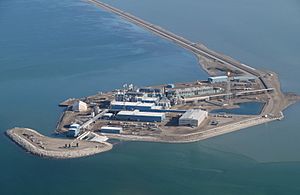Endicott Island facts for kids
Endicott Island is a man-made island in Alaska, a state in the United States. It is about 45 acres big, which is like 34 football fields! The island is located 2.5 miles (4 km) offshore in the Beaufort Sea, near Prudhoe Bay, Alaska.
Endicott Island was built in 1987 by a company called Alaska Interstate Construction. Today, companies like BP and Hilcorp Alaska use it to find and produce oil. Unlike some other oil islands, Endicott Island is connected to the mainland by a permanent road called a causeway.
Oil Production at Endicott Island
Endicott Island was special because it was the first place in the Arctic to continuously produce oil from offshore. This means it kept pumping oil without stopping.
Every day, about 20,000 barrels of oil were produced here. By March 2003, the island had produced a huge amount of oil, around 423 million barrels!
After the oil is processed on the island, it travels through a 24-mile (39 km) pipeline. This pipeline connects to the much larger Trans-Alaska Pipeline, which then carries the oil all the way to Valdez, Alaska.
Protecting the Environment
In the late 1990s, there were some problems with how waste was handled on Endicott Island. Companies were found to have disposed of waste materials improperly.
To fix this, the companies involved had to pay large amounts of money. They also agreed to create better ways to manage waste and protect the environment at their oil sites. This included setting up a $15 million environmental management system. This system helps make sure that oil exploration and production are done in a way that is safer for nature.
See also
 In Spanish: Isla Endicott para niños
In Spanish: Isla Endicott para niños


